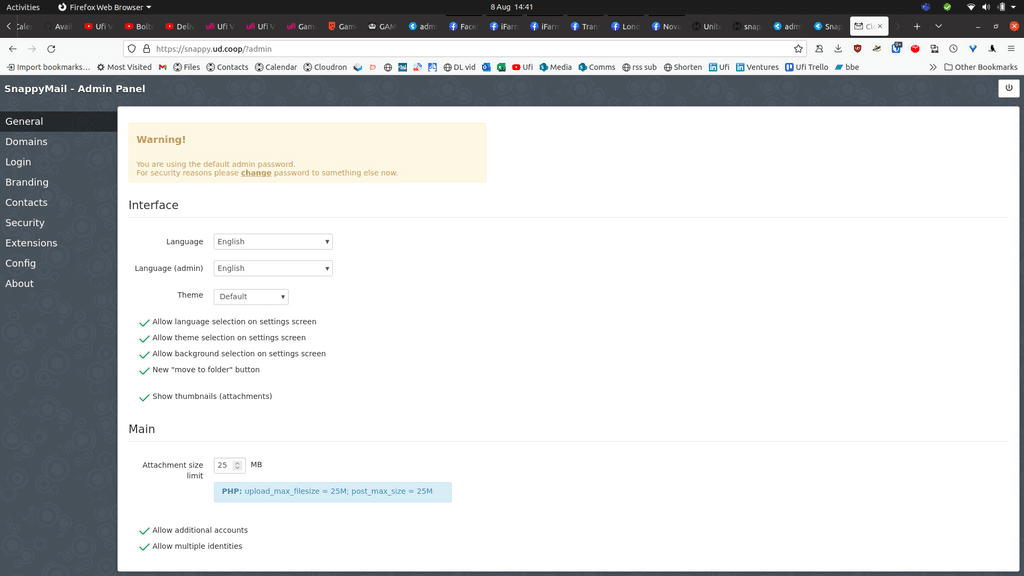problem logging into /?admin
-
coming from rainloop some things changed in regard to login to the ../?admin URL.
this
Admin panel The admin panel is located at /?admin and is disabled by default. To enable it, open a File manager and edit the file /app/data/_data_/_default_/configs/application.ini. Set the value of allow_admin_panel to On. You can now login with the username admin. The password is located at /app/data/_data_/_default_/admin_password.txt. Restart the app for the changes to take effect.from here: https://docs.cloudron.io/apps/snappymail/ doesn't seem to work in my app.
I found that I have a line
admin_password =in /app/data/data/default/configs/application.ini in addition to the file /app/data/data/default/admin_password.txt which seems redundant.
anyways, no combination of passwords in any of these files helped (app has been restarted)
-
See
@jdaviescoates said in admin panel - authentication failed:
@perler said in admin panel - authentication failed:
that's not my point. there is a lineadmin_password =
(not allow_admin_panel = ) AND the file admin_password.txt which seems redundant.
I will open a thread in the snappymail categorie, thanks @jdaviescoatesI see what you mean.
But on a new install I don't have any
admin_password =But nor do I have anyadmin_password.txtfile to edit!Ah, I think that file gets created on the restarted after enabling
allow_admin_panel = OnI had manually created and written a pw just before the restart, but that didn't work because the restart generated the pw and inserted it into that file.
But now I'm in:

-
If you start with a new install that
admin_password =will not be there.I just tested and these instructions definitely work:
- install Snappymail at
yourdomain.coop - Use the File Manager to edit
/app/data/_data_/_default_/configs/application.iniso thatallow_admin_panel = On - Visit
yourdomain.coop/?admin(doing so generates theadmin_password.txtfile and writes the pw inside it) - Use the File Manage to open
app/data/_data_/_default_/admin_password.txtand copy the password that is now there. - Browse to
yourdomain.coop/?adminagain - login using user: admin pw: what you copied in step 4.
- Reset the admin password again using the admin user interface.
No app restarts necessary, see:
@staff I think the main problem with the docs is you don't include
- In order for the
admin_password.txtfile to be generated you have to visit/@adminfirst - that the admin username is
admin
- install Snappymail at
-
coming from rainloop some things changed in regard to login to the ../?admin URL.
this
Admin panel The admin panel is located at /?admin and is disabled by default. To enable it, open a File manager and edit the file /app/data/_data_/_default_/configs/application.ini. Set the value of allow_admin_panel to On. You can now login with the username admin. The password is located at /app/data/_data_/_default_/admin_password.txt. Restart the app for the changes to take effect.from here: https://docs.cloudron.io/apps/snappymail/ doesn't seem to work in my app.
I found that I have a line
admin_password =in /app/data/data/default/configs/application.ini in addition to the file /app/data/data/default/admin_password.txt which seems redundant.
anyways, no combination of passwords in any of these files helped (app has been restarted)
@perler said in problem logging into /?admin:
in /app/data/data/default/configs/application.ini in addition to the file /app/data/data/default/admin_password.txt which seems redundant.
The application.ini holds the hashed password. Whereas the txt file holds the raw password . Note that this comes from the upstream project. My understanding is that it is this way because in Rainloop code base application.ini used to hold the raw password. The author of snappymail has since changed it so that application.ini has the hashed password. I am not sure but I think admin_password.txt can possibly be deleted after you made a note of the password. This then secures the setup if application.ini gets leaked somehow.
-
If you start with a new install that
admin_password =will not be there.I just tested and these instructions definitely work:
- install Snappymail at
yourdomain.coop - Use the File Manager to edit
/app/data/_data_/_default_/configs/application.iniso thatallow_admin_panel = On - Visit
yourdomain.coop/?admin(doing so generates theadmin_password.txtfile and writes the pw inside it) - Use the File Manage to open
app/data/_data_/_default_/admin_password.txtand copy the password that is now there. - Browse to
yourdomain.coop/?adminagain - login using user: admin pw: what you copied in step 4.
- Reset the admin password again using the admin user interface.
No app restarts necessary, see:
@staff I think the main problem with the docs is you don't include
- In order for the
admin_password.txtfile to be generated you have to visit/@adminfirst - that the admin username is
admin
@jdaviescoates said in problem logging into /?admin:
In order for the admin_password.txt file to be generated you have to visit /@admin first
You are right, will fix the docs.
- install Snappymail at
-
@jdaviescoates said in problem logging into /?admin:
In order for the admin_password.txt file to be generated you have to visit /@admin first
You are right, will fix the docs.
-
@perler said in problem logging into /?admin:
in /app/data/data/default/configs/application.ini in addition to the file /app/data/data/default/admin_password.txt which seems redundant.
The application.ini holds the hashed password. Whereas the txt file holds the raw password . Note that this comes from the upstream project. My understanding is that it is this way because in Rainloop code base application.ini used to hold the raw password. The author of snappymail has since changed it so that application.ini has the hashed password. I am not sure but I think admin_password.txt can possibly be deleted after you made a note of the password. This then secures the setup if application.ini gets leaked somehow.
@girish said in problem logging into /?admin:
admin_password.txt can possibly be deleted after you made a note of the password
This seems to happen all by itself, actually.
Also, once you're in the admin panel it suggests changing the password again using the UI, so that should prob go in the docs too.
-
Has the procedure of getting into the admin panel changed?
- I set
allow_admin_panel = Onin/app/data/_data_/_default_/configs/application.ini - restarted app
- when I visit
snappymail.mydomain.tld/?adminI get an error "Access to the SnappyMail Admin Panel is not allowed!" - In the log, the only relevant entry seems to be
Nov 17 06:16:47 82.##.##.## - - [17/Nov/2023:05:16:47 +0000] "GET /?admin HTTP/1.1" 403 1086 "-" "Mozilla/5.0 (Macintosh; Intel Mac OS X 10_15_7) AppleWebKit/537.36 (KHTML, like Gecko)" - I set
-
No, there's no reason to restart the app.
Check the .ini file again and save it, then visit the admin url again.Works just fine on the demo server.
@robi me stupid. I had two entries with
allow_admin_panel, one was "On", one was "Off"
-
 N nebulon marked this topic as a question on
N nebulon marked this topic as a question on
-
 N nebulon has marked this topic as solved on
N nebulon has marked this topic as solved on
